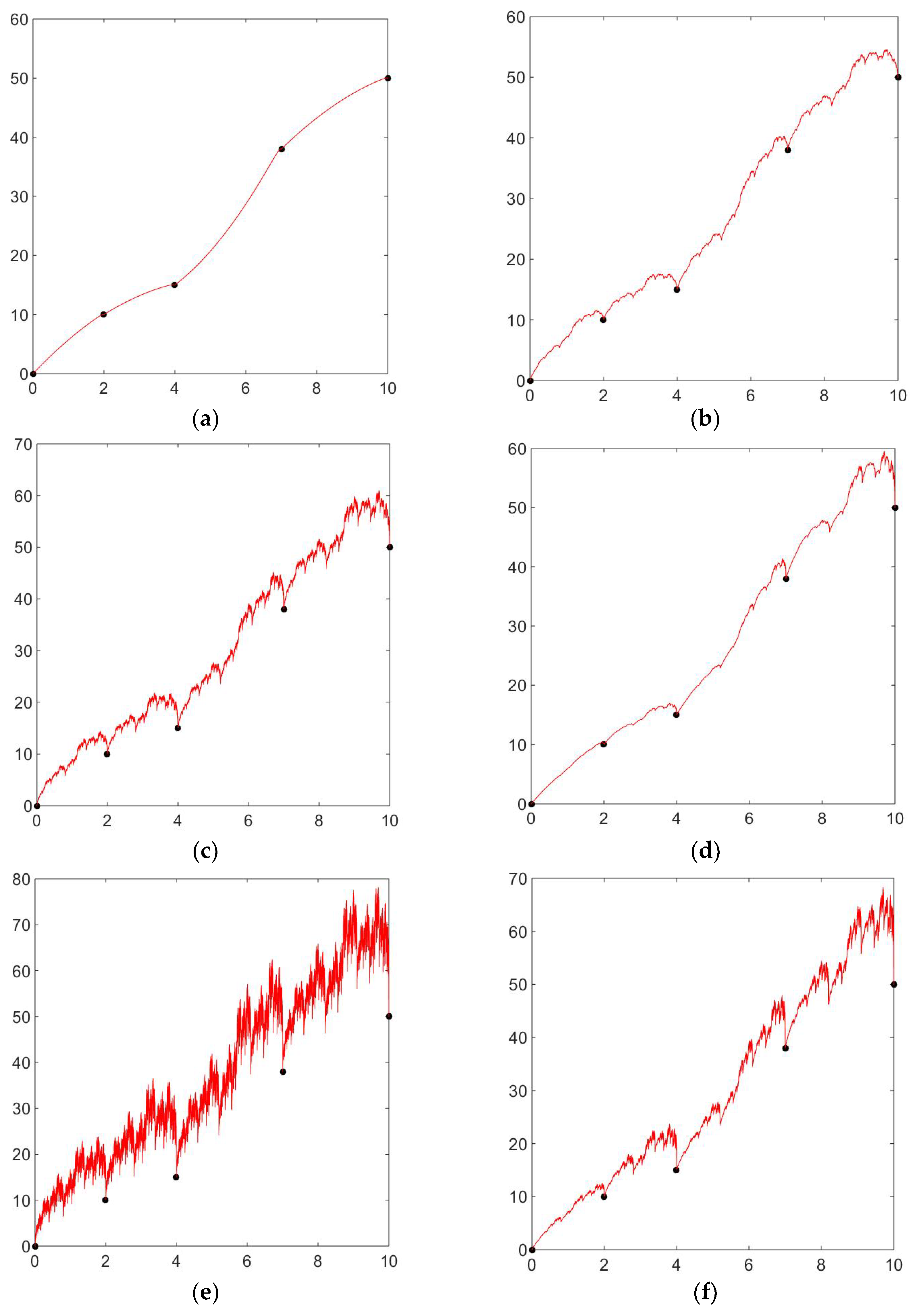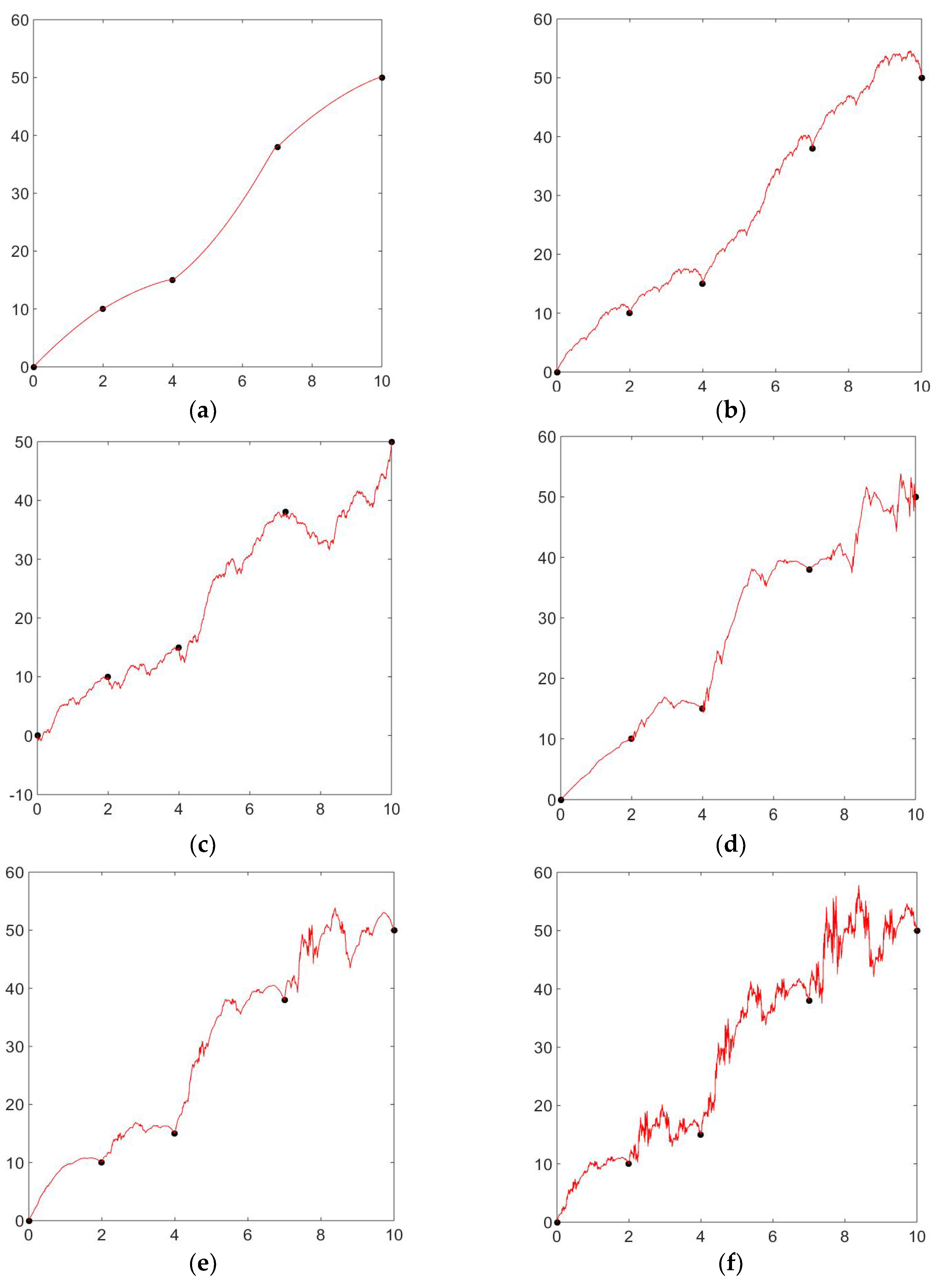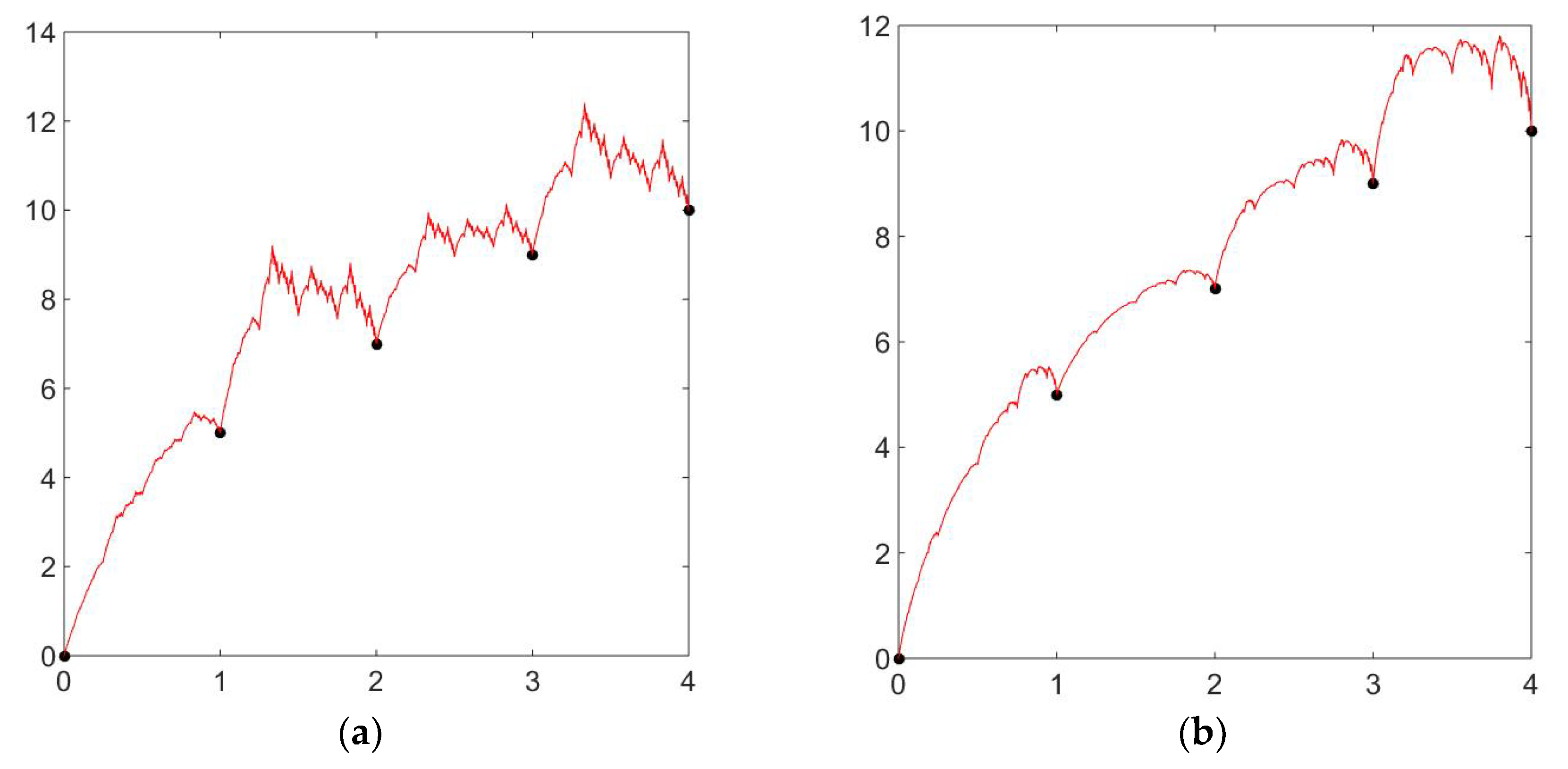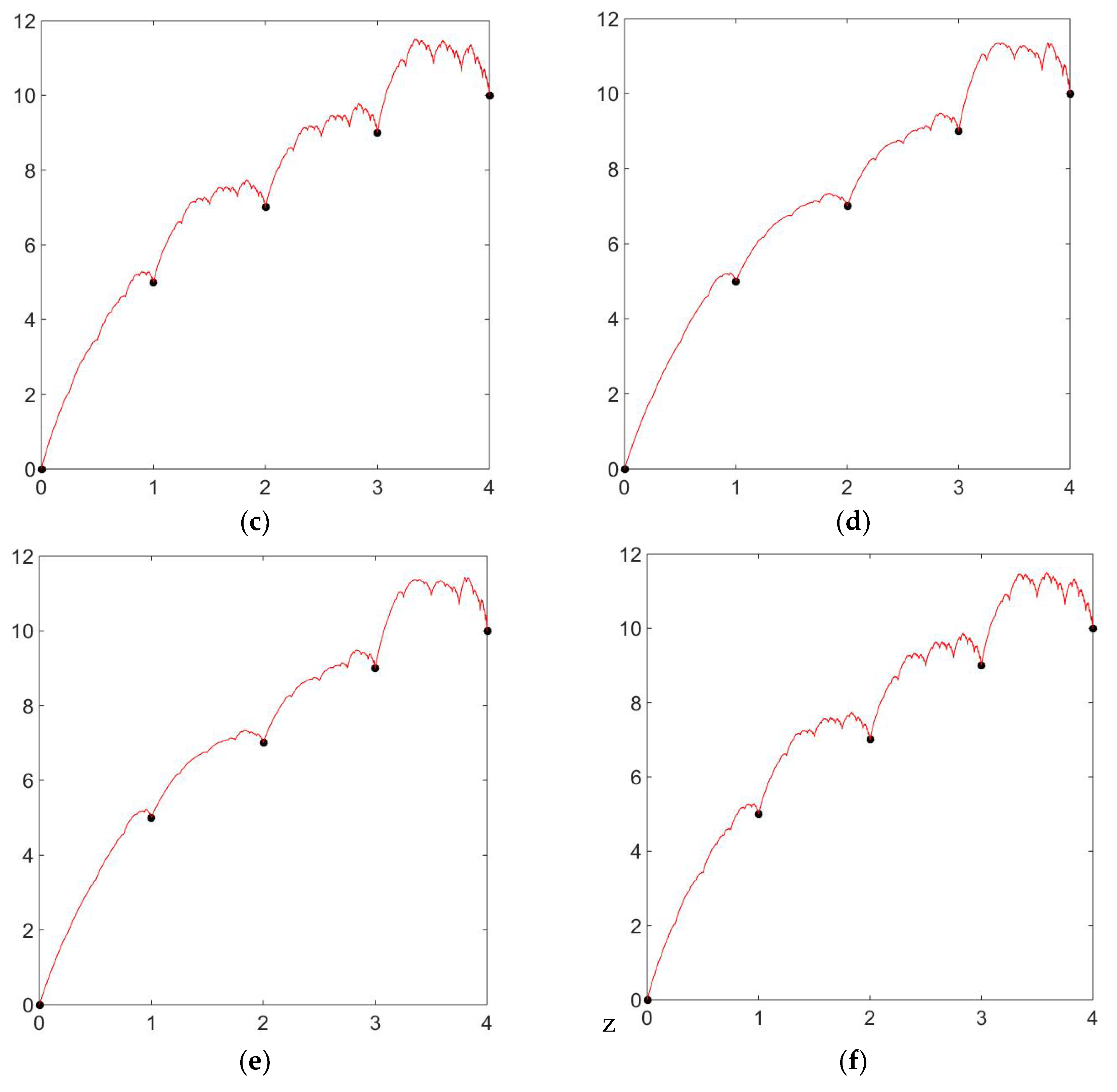Positivity-Preserving Rational Cubic Fractal Interpolation Function Together with Its Zipper Form
Abstract
:1. Introduction
2. Basics of Fractal Interpolation Functions and Zipper Fractal Interpolation Functions
2.1. Fractal Interpolation Function
2.2. Zipper Fractal Interpolation Function
- There is a unique compact set such that
- The continuous function that interpolates the dataset , i.e.,
3. Construction of Rational Cubic Fractal Interpolation Function and Zipper-Rational Cubic Fractal Interpolation Function
3.1. C1—Rational Cubic Fractal Interpolation Function
3.2. C1-Zipper-Rational Cubic Fractal Interpolation Function
4. Convergence of Rational Cubic Fractal Interpolation Function and Zipper-Rational Cubic Fractal Interpolation Function
5. Constrained Rational Cubic Fractal Interpolation Function and Zipper-Rational Cubic Fractal Interpolation Function
6. Positivity of Rational Cubic Fractal Interpolation Function and Zipper-Rational Cubic Fractal Interpolation Function
7. Conclusions and Future Work
Author Contributions
Funding
Data Availability Statement
Conflicts of Interest
References
- Schmidt, J.W.; Heß, W. Positivity of cubic polynomials on intervals and positive spline interpolation. BIT Numer. Math. 1988, 28, 340–352. [Google Scholar] [CrossRef]
- Butt, S.; Brodlie, K.W. Preserving positivity using piecewise cubic interpolation. Comput. Graph. 1993, 17, 55–64. [Google Scholar] [CrossRef]
- Sarfraz, M.; Hussain, M.Z. Data visualization using rational spline interpolation. J. Comput. Appl. Math. 2006, 189, 513–525. [Google Scholar] [CrossRef]
- Hussain, M.Z.; Sarfraz, M. Positivity-preserving interpolation of positive data by rational cubics. J. Comput. Appl. Math. 2008, 218, 446–458. [Google Scholar] [CrossRef]
- Chernous’ ko, F.L.; Ananievski, I.M.; Reshmin, S.A. Control of Nonlinear Dynamical Systems: Methods and Applications; Springer Science & Business Media: Berlin/Heidelberg, Germany, 2008. [Google Scholar]
- Jayaraman, A.; Belmonte, A. Oscillations of a solid sphere falling through a wormlike micellar fluid. Phys. Rev. E. 2003, 67, 065301. [Google Scholar] [CrossRef]
- Massopust, P. Interpolation and Approximation with Splines and Fractals; Oxford University Press, Inc.: Oxford, UK, 2010. [Google Scholar]
- Barnsley, M.F. Fractals Everywhere; Academic Press: Cambridge, MA, USA, 2014. [Google Scholar]
- Gibert, S.; Massopust, P.R. The exact Hausdorff dimension for a class of fractal functions. J. Math. Anal. Appl. 1992, 168, 171–183. [Google Scholar] [CrossRef]
- Barnsley, M.F. Fractal functions and interpolation. Constr. Approx. 1986, 2, 303–329. [Google Scholar] [CrossRef]
- Hutchinson, J.E. Fractals and self similarity. Indiana Univ. Math. J. 1981, 30, 713–747. [Google Scholar] [CrossRef]
- Barnsley, M.F.; Harrington, A.N. The calculus of fractal interpolation functions. J. Approx. Theory 1989, 57, 14–34. [Google Scholar] [CrossRef]
- Navascués, M.A.; Sebastián, M.V. Smooth fractal interpolation. J. Inequalities Appl. 2006, 2006, 78734. [Google Scholar] [CrossRef]
- Prasad, B.; Katiyar, K.; Singh, B. Trigonometric quadratic fractal interpolation functions. Int. J. Appl. Eng. Res. 2015, 37, 290–302. [Google Scholar]
- Garg, S.; Katiyar, K. A new type of zipper fractal interpolation surfaces and associated bivariate zipper fractal operator. J. Anal. 2023, 31, 3021–3043. [Google Scholar] [CrossRef]
- Gautam, S.S.; Katiyar, K. Alpha fractal rational quintic spline with shape preserving properties. Int. J. Comput. Appl. Math. Comput. Sci. 2023, 3, 113–121. [Google Scholar] [CrossRef]
- Chand, A.K.B.; Vijender, N.; Navascués, M.A. Shape preservation of scientific data through rational fractal splines. Calcolo 2014, 51, 329–362. [Google Scholar] [CrossRef]
- Reddy, K.M.; Chand, A.K.; Viswanathan, P. Data visualization by rational fractal function based on function values. J. Anal. 2020, 28, 261–277. [Google Scholar] [CrossRef]
- Navascués, M.A. Fractal polynomial interpolation. Z. Anal. Ihre Anwendungen 2005, 24, 401–418. [Google Scholar] [CrossRef]
- Banerjee, A.; Akhtar, M.N.; Navascués, M.A. Local α-fractal interpolation function. Eur. Phys. J. Spec. Top. 2023, 232, 1043–1050. [Google Scholar] [CrossRef]
- Feng, Z.; Sun, X. Box-counting dimensions of fractal interpolation surfaces derived from fractal interpolation functions. J. Math. Anal. Appl. 2014, 412, 416–425. [Google Scholar] [CrossRef]
- Akhtar, M.N.; Prasad, M.G.; Navascués, M.A. Box dimensions of α-fractal functions. Fractals 2016, 24, 1650037. [Google Scholar] [CrossRef]
- Nayak, S.R.; Mishra, J.; Palai, G. Analysing roughness of surface through fractal dimension: A review. Image Vis. Comput. 2019, 89, 21–34. [Google Scholar] [CrossRef]
- Ri, S. New types of fractal interpolation surfaces. Chaos Solitons Fractals 2019, 119, 291–307. [Google Scholar] [CrossRef]
- Navascués, M.A.; Akhtar, M.N.; Mohapatra, R. Fractal frames of functions on the rectangle. Fractal Fract. 2021, 5, 42. [Google Scholar] [CrossRef]
- Pandey, M.; Som, T.; Verma, S. Fractal dimension of Katugampola fractional integral of vector-valued functions. Eur. Phys. J. Spec. Top. 2021, 230, 3807–3814. [Google Scholar] [CrossRef]
- Navascués, M.A. Fractal curves on Banach algebras. Fractal Fract. 2022, 6, 722. [Google Scholar] [CrossRef]
- He, C.H.; Liu, C. Fractal dimensions of a porous concrete and its effect on the concrete’s strength. Facta Univ. Ser. Mech. Eng. 2023, 21, 137–150. [Google Scholar] [CrossRef]
- Lal, R.; Selmi, B.; Verma, S. On Dimension of Fractal Functions on Product of the Sierpiński Gaskets and Associated Measures. Results Math. 2024, 79, 73. [Google Scholar] [CrossRef]
- Navascués, M.A. Approximation of fixed points and fractal functions by means of different iterative algorithms. Chaos Solitons Fractals 2024, 180, 114535. [Google Scholar] [CrossRef]
- Chandra, S.; Verma, S.; Abbas, S. Construction of fractal functions using Kannan mappings and smoothness analysis. arXiv 2023, arXiv:2301.03075. [Google Scholar]
- Thangaraj, C.; Easwaramoorthy, D.; Selmi, B.; Chamola, B.P. Generation of fractals via iterated function system of Kannan contractions in controlled metric space. Math. Comput. Simul. 2024, 222, 188–198. [Google Scholar] [CrossRef]
- Garg, S.; Katiyar, K. Positivity and monotonicity shape preserving using rational quintic fractal interpolation functions. Adv. Math. Sci. J. 2020, 9, 5511–5520. [Google Scholar]
- Tyada, K.R.; Chand, A.K.B.; Sajid, M. Shape preserving rational cubic trigonometric fractal interpolation functions. Math. Comput. Simulation. 2021, 90, 866–891. [Google Scholar] [CrossRef]
- Ibraheem, F.; Hussain, M.; Hussain, M.Z.; Bhatti, A.A. Positive data visualization using trigonometric function. J. Appl. Math. 2012, 2012, 247120. [Google Scholar] [CrossRef]
- Dube, M.; Rana, P.S. Positivity preserving interpolation of positive data by rational quadratic trigonometric spline. IOSR J. Math. 2014, 10, 42–47. [Google Scholar] [CrossRef]
- Hussain, M.Z.; Ali, J. Positivity-preserving piecewise rational cubic interpolation. Matematika 2006, 22, 147–153. [Google Scholar]
- Piah, A.R.M.; Unsworth, K. Improved sufficient conditions for monotonic piecewise rational quartic interpolation. Sains Malays. 2011, 40, 1173–1178. [Google Scholar]
- Abbas, M.; Majid, A.A.; Ali, J.M. Monotonicity-preserving C2 rational cubic spline for monotone data. Appl. Math. Comput. 2012, 219, 2885–2895. [Google Scholar] [CrossRef]
- Chand, A.K.B.; Vijender, N. Monotonicity preserving rational quadratic fractal interpolation functions. Adv. Numer. Anal. 2014, 2014, 504825. [Google Scholar] [CrossRef]
- Dube, M.; Tiwari, P. Convexity preserving C2 rational quadratic trigonometric spline. Int. J. Sci. Res. Publ. 2012, 3, 401. [Google Scholar]
- Sharma, S.; Katiyar, K. Preserving convexity through C2 rational quintic fractal interpolation function. InAIP Conf. Proc. 2023, 2735, 040015. [Google Scholar]
- Brodlie, K.W.; Butt, S. Preserving convexity using piecewise cubic interpolation. Comput. Graph. 1991, 15, 15–23. [Google Scholar] [CrossRef]
- Viswanathan, P.; Chand, A.K.B.; Agarwal, R.P. Preserving convexity through rational cubic spline fractal interpolation function. J. Comput. Appl. Math. 2014, 263, 262–276. [Google Scholar] [CrossRef]
- Aseev, V.V.; Tetenov, A.V.; Kravchenko, A.S. On selfsimilar Jordan curves on the plane. Sib. Math. J. 2003, 44, 379–386. [Google Scholar] [CrossRef]
- Aseev, V.V.; Tetenov, A.V. On the self-similar Jordan arcs admitting structure parametrization. Sib. Math. J. 2005, 46, 581–592. [Google Scholar] [CrossRef]
- Jha, S.; Chand, A.K.B. Zipper rational quadratic fractal interpolation functions. In Proceedings of the Fifth International Conference on Mathematics and Computing: ICMC; Springer: Singapore, 2020; pp. 229–241. [Google Scholar]
- Chand, A.K.B. Zipper fractal functions with variable scalings. Adv. Theory Nonlinear Anal. Appl. 2022, 6, 481–501. [Google Scholar]
- Vijay; Chand, A.K.B. Convexity-preserving rational cubic zipper fractal interpolation curves and surfaces. Math. Comput. Appl. 2023, 28, 74. [Google Scholar]
- Chand, A.K.B.; Vijender, N.; Viswanathan, P.; Tetenov, A.V. Affine zipper fractal interpolation functions. BIT Numer. Math. 2020, 60, 319–344. [Google Scholar] [CrossRef]
- Aseev, V.V. On the regularity of self-similar zippers. In Proceedings of the 6-th Russian-Korean International Symposium on Science and Technology, KORUS-2002, Novosibirsk, Russia, 24–30 June 2002; p. 167. [Google Scholar]
- Duan, Q.; Djidjeli, K.; Price, W.G.; Twizell, E.H. The approximation properties of some rational cubic splines. Int. J. Comput. Math. 1999, 72, 155–166. [Google Scholar] [CrossRef]





Disclaimer/Publisher’s Note: The statements, opinions and data contained in all publications are solely those of the individual author(s) and contributor(s) and not of MDPI and/or the editor(s). MDPI and/or the editor(s) disclaim responsibility for any injury to people or property resulting from any ideas, methods, instructions or products referred to in the content. |
© 2024 by the authors. Licensee MDPI, Basel, Switzerland. This article is an open access article distributed under the terms and conditions of the Creative Commons Attribution (CC BY) license (https://creativecommons.org/licenses/by/4.0/).
Share and Cite
Sharma, S.; Katiyar, K.; Sudhamsu, G.; Wratch, M.K.; Salgotra, R. Positivity-Preserving Rational Cubic Fractal Interpolation Function Together with Its Zipper Form. Axioms 2024, 13, 584. https://doi.org/10.3390/axioms13090584
Sharma S, Katiyar K, Sudhamsu G, Wratch MK, Salgotra R. Positivity-Preserving Rational Cubic Fractal Interpolation Function Together with Its Zipper Form. Axioms. 2024; 13(9):584. https://doi.org/10.3390/axioms13090584
Chicago/Turabian StyleSharma, Shamli, Kuldip Katiyar, Gadug Sudhamsu, Manjinder Kaur Wratch, and Rohit Salgotra. 2024. "Positivity-Preserving Rational Cubic Fractal Interpolation Function Together with Its Zipper Form" Axioms 13, no. 9: 584. https://doi.org/10.3390/axioms13090584





